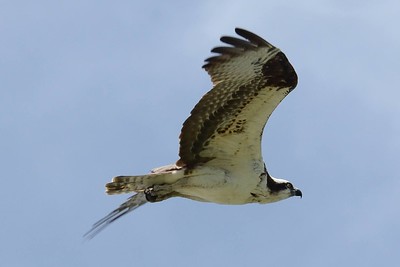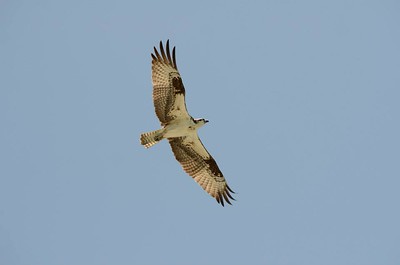Ospreys Nesting at Mesa College
Teaching and learning goes on day in and day out at Mesa College, with many students, staff, faculty and visitors unaware that high above the campus, atop a light over the soccer courts on the east side of the college, a resident pair of Ospreys call Mesa College home.
During late afternoons/early evenings, the low-flying Osprey often cruise the length of the campus. With a wingspan of 54 to 72 inches, the loud-chirping brown and white birds are hard to miss. Fish eaters, they are thought to fly west to the mouth of the San Diego River in search of prey, and often bring their catch home for the kill, which explains the fish carcasses sometimes found by athletes in fields around their nest.
Their nest is actually built atop a man-made metal basket; hand-made by Mesa athletics and facilities staff.


Olympians Welcome Ospreys to their Home
In Spring 2001, a pair of the rare birds of prey began nesting atop a light pole at the campus football stadium. They even started a family there. Out of concern for the pair, Facilities Services staff and the Physical Education/Athletics Department agreed to keep the Osprey’s light pole dark.
Then in June, they got a call from the State Department of Fish and Game (DFG). "It is extremely rare to find a nest in San Diego," DFG representative David Mayer said. While Ospreys are not on the endangered list, at the time they were a bird of "special concern," with only three nests in San Diego County.


Athletics Dean Dave Evans found himself in the middle of a dilemma: the safety of students and spectators versus the safety of rare birds. Mesa’s Facilities staff came up with a solution that Dean Evans quickly approved - to build the birds their own nest.
In Fall 2001, Facilities Services staff Robert Renfro, Angelo Pellegrini, and Jason and Gene Botticelli constructed and installed a 250-pound nest out of metal grating and piping over the course of a few weeks. Using a large crane, Pellegrini climbed the 60-foot light pole to install it.
The nest sits about nine feet above the light, is eight feet tall, and measures seven feet in diameter. With the nesting platform now high above the lights, it was no longer a safety concern, and the lights came back on for Olympian players and their fans.
The Osprey quickly took to their new digs. "This collaborative effort was a win-win situation for everyone, " Dean Evans declared.
Since then, the ospreys have called Mesa home, presenting up to three chicklets; usually around Mother’s Day.

Learn More
Check out the YouTube video of our nesting Ospreys.
See more photos from the San Diego Union Tribune.



